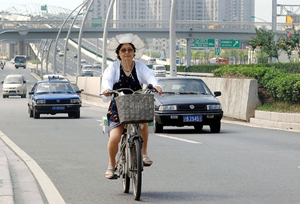| Home / China / Local News | Tools: Save | Print | E-mail | Most Read |
| Shanghai Plans to Build Cycle Lanes |
| Adjust font size: |
Shanghai plans to build cycle lanes on the newly opened Middle Ring Road, a city official said yesterday.
The scheme follows a newspaper report that cyclists and scooter drivers were being forced to illegally use the same lanes as cars and trucks because parts of the road only had vehicle lanes. A preliminary plan aims to turn one fifth of the existing traffic lanes along the ground section of Middle Ring Road into a cycle lane. City planners said a network of minor streets around the arterial ring road will also be for people on two-wheels. "We are considering a plan to convenience cyclists," an official surnamed Wang from the Shanghai Engineering Administrative Bureau said yesterday. According to traffic planners, the Puxi section of the Middle Ring Road, about 38-kilometers long, does not allow cyclists and scooter drivers to use even the non-elevated sections of the road. However, most of the ring road's ground roads - such as Zhenbei Road and Wenshui Road - were originally open to both vehicles and cyclists. A recent report in a Chinese newspaper said many cyclists and scooter drivers were being forced to vie with vehicles on the Middle Ring Road along Tianshan Road. A similar dilemma faces cyclists in the Dabaishu and Wujiaochang areas. Zhao Guotong, a city transport and environmental protection expert, said it was unreasonable to ban cycling on the ring road because many ordinary people depend on two-wheels to get around in rush hour traffic. "Public transport, bicycle and scooters are a vital means of transport for a modern city," he said. He said in many Western countries, such as Britain, Norway and Denmark, governments encourage cyclists and discourage cars. He said in Vienna, Austria, more than 40 percent of people ride bikes. Late last year, the city government announced a plan to build a 160km cycling network. Some of the lanes will be gained by widening roads and others by rearranging existing roads. Cai Yifeng, an urban planning expert from the Shanghai Transportation Planning Institute, said: "Ground public traffic and cycling should play a bigger role to alleviate local traffic congestions before the World Expo (in 2010)." (Shanghai Daily June 30, 2006)) |
| Tools: Save | Print | E-mail | Most Read |
 |
| Related Stories |
|
